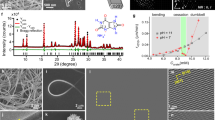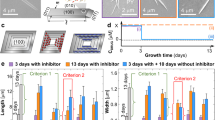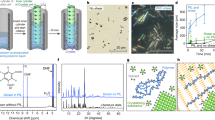Abstract
Ubiquitous processes in nature and the industry exploit crystallization from multicomponent environments1,2,3,4,5; however, laboratory efforts have focused on the crystallization of pure solutes6,7 and the effects of single growth modifiers8,9. Here we examine the molecular mechanisms employed by pairs of inhibitors in blocking the crystallization of haematin, which is a model organic compound with relevance to the physiology of malaria parasites10,11. We use a combination of scanning probe microscopy and molecular modelling to demonstrate that inhibitor pairs, whose constituents adopt distinct mechanisms of haematin growth inhibition, kink blocking and step pinning12,13, exhibit both synergistic and antagonistic cooperativity depending on the inhibitor combination and applied concentrations. Synergism between two crystal growth modifiers is expected, but the antagonistic cooperativity of haematin inhibitors is not reflected in current crystal growth models. We demonstrate that kink blockers reduce the line tension of step edges, which facilitates both the nucleation of crystal layers and step propagation through the gates created by step pinners. The molecular viewpoint on cooperativity between crystallization modifiers provides guidance on the pairing of modifiers in the synthesis of crystalline materials. The proposed mechanisms indicate strategies to understand and control crystallization in both natural and engineered systems, which occurs in complex multicomponent media1,2,3,8,9. In a broader context, our results highlight the complexity of crystal–modifier interactions mediated by the structure and dynamics of the crystal interface.
This is a preview of subscription content, access via your institution
Access options
Access Nature and 54 other Nature Portfolio journals
Get Nature+, our best-value online-access subscription
$29.99 / 30 days
cancel any time
Subscribe to this journal
Receive 51 print issues and online access
$199.00 per year
only $3.90 per issue
Buy this article
- Purchase on Springer Link
- Instant access to full article PDF
Prices may be subject to local taxes which are calculated during checkout




Similar content being viewed by others
Data availability
The datasets generated during and/or analysed during the current study are available from the corresponding authors on reasonable request.
Code availability
The custom computer code used in these simulations is available upon reasonable request to J.F.L. (jim@lutsko.com).
References
Marin, F. & Luquet, G. Molluscan biomineralization: the proteinaceous shell constituents of Pinna nobilis L. Mater. Sci. Eng. C 25, 105–111 (2005).
Porter, S. M. Seawater chemistry and early carbonate biomineralization. Science 316, 1302 (2007).
Myerson, A. S. Handbook of Industrial Crystallization 2nd edn (Butterworth-Heinemann, 2001).
Sangwal, K. Additives and Crystallization Processes: From Fundamentals to Applications (John Wiley & Sons, 2007).
De Yoreo, J. J. Physical mechanisms of crystal growth modification by biomolecules. AIP Conf. Proc. 1270, 45–58 (2010).
Orme, C. A. et al. Formation of chiral morphologies through selective binding of amino acids to calcite surface steps. Nature 411, 775–779 (2001).
De Yoreo, J. J. et al. Crystallization by particle attachment in synthetic, biogenic, and geologic environments. Science 349, aaa6760 (2015).
Elhadj, S., De Yoreo, J. J., Hoyer, J. R. & Dove, P. M. Role of molecular charge and hydrophilicity in regulating the kinetics of crystal growth. Proc. Natl Acad. Sci. USA 103, 19237–19242 (2006).
Ferrer, M. D. et al. A novel pharmacodynamic assay to evaluate the effects of crystallization inhibitors on calcium phosphate crystallization in human plasma. Sci. Rep. 7, 6858 (2017).
Pagola, S., Stephens, P. W., Bohle, D. S., Kosar, A. D. & Madsen, S. K. The structure of malaria pigment β-haematin. Nature 404, 307–310 (2000).
Sullivan, D. J., Matile, H., Ridley, R. G. & Goldberg, D. E. A common mechanism for blockade of heme polymerization by antimalarial quinolines. J. Biol. Chem. 273, 31103–31107 (1998).
Olafson, K. N., Ketchum, M. A., Rimer, J. D. & Vekilov, P. G. Mechanisms of hematin crystallization and inhibition by the antimalarial drug chloroquine. Proc. Natl Acad. Sci. USA 112, 4946–4951 (2015).
Olafson, K. N., Nguyen, T. Q., Rimer, J. D. & Vekilov, P. G. Antimalarials inhibit hematin crystallization by unique drug–surface site interactions. Proc. Natl Acad. Sci. USA 114, 7531–7536 (2017).
Van Horn, H. M. The crystallization of white dwarf stars. Nat. Astron. 3, 129–130 (2019).
Reznikov, N., Steele, J. A. M., Fratzl, P. & Stevens, M. M. A materials science vision of extracellular matrix mineralization. Nat. Rev. Mater. 1, 16041 (2016).
De Yoreo, J. J. & Vekilov, P. G. Principles of crystal nucleation and growth. Rev. Mineral. Geochem. 54, 57–93 (2003).
Olafson, K. N., Li, R., Alamani, B. G. & Rimer, J. D. Engineering crystal modifiers: bridging classical and nonclassical crystallization. Chem. Mater. 28, 8453–8465 (2016).
Rae Cho, K. et al. Direct observation of mineral–organic composite formation reveals occlusion mechanism. Nat. Commun. 7, 10187 (2016).
Weiner, S. & Addadi, L. Design strategies in mineralized biological materials. J. Mater. Chem. 7, 689–702 (1997).
Meldrum, F. C. & Cölfen, H. Controlling mineral morphologies and structures in biological and synthetic systems. Chem. Rev. 108, 4332–4432 (2008).
Farmanesh, S. et al. Specificity of growth inhibitors and their cooperative effects in calcium oxalate monohydrate crystallization. J. Am. Chem. Soc. 136, 367–376 (2014).
Ridley, R. G. Medical need, scientific opportunity and the drive for antimalarial drugs. Nature 415, 686–693 (2002).
Sullivan, D. J., Gluzman, I. Y., Russell, D. G. & Goldberg, D. E. On the molecular mechanism of chloroquine’s antimalarial action. Proc. Natl Acad. Sci. USA 93, 11865–11870 (1996).
Gorka, A. P., de Dios, A. & Roepe, P. D. Quinoline drug–heme interactions and implications for antimalarial cytostatic versus cytocidal activities. J. Med. Chem. 56, 5231–5246 (2013).
Cabrera, N. & Vermilyea, D. A. in Growth and Perfection of Crystals Vol. 393–408 (eds Doremus, R. H. et al.) 393–408 (Wiley, 1958).
Eastman, R. T. & Fidock, D. A. Artemisinin-based combination therapies: a vital tool in efforts to eliminate malaria. Nat. Rev. Microbiol. 7, 864–874 (2009).
Mott, B. T. et al. High-throughput matrix screening identifies synergistic and antagonistic antimalarial drug combinations. Sci. Rep. 5, 13891 (2015).
Gorka, A. P., Jacobs, L. M. & Roepe, P. D. Cytostatic versus cytocidal profiling of quinoline drug combinations via modified fixed-ratio isobologram analysis. Malar. J. 12, 332 (2013).
Chou, T.-C. Theoretical basis, experimental design, and computerized simulation of synergism and antagonism in drug combination studies. Pharmacol. Rev. 58, 621–681 (2006).
Egan, T. J. Interactions of quinoline antimalarials with hematin in solution. J. Inorg. Biochem. 100, 916–926 (2006).
Gibbs, J. W. On the equilibrium of heterogeneous substances (first part). Trans. Connect. Acad. Sci. 3, 108–248 (1876).
Lutsko, J. F. et al. Crystal growth cessation revisited: the physical basis of step pinning. Cryst. Growth Des. 14, 6129–6134 (2014).
Ketchum, M. A., Lee, A. M., Vekilov, P. G. & Rimer, J. D. Biomimetic assay for hematin crystallization inhibitors: a new platform to screen antimalarial drugs. Cryst. Growth Des. 17, 197–206 (2017).
Ketchum, M. A., Olafson, K. N., Petrova, E. V., Rimer, J. D. & Vekilov, P. G. Hematin crystallization from aqueous and organic solvents. J. Chem. Phys. 139, 121911 (2013).
Olafson, K. N., Rimer, J. D. & Vekilov, P. G. Growth of large hematin crystals in biomimetic solutions. Cryst. Growth Des. 14, 2123–2127 (2014).
Olafson, K. N., Ketchum, M. A., Rimer, J. D. & Vekilov, P. G. Molecular mechanisms of hematin crystallization from organic solvent. Cryst. Growth Des. 15, 5535–5542 (2015).
Yau, S.-T., Thomas, B. R. & Vekilov, P. G. Molecular mechanisms of crystallization and defect formation. Phys. Rev. Lett. 85, 353–356 (2000).
Yau, S.-T. & Vekilov, P. G. Quasi-planar nucleus structure in apoferritin crystallisation. Nature 406, 494–497 (2000).
Yau, S.-T., Thomas, B. R., Galkin, O., Gliko, O. & Vekilov, P. G. Molecular mechanisms of microheterogeneity-induced defect formation in ferritin crystallization. Proteins 43, 343–352 (2001).
Petsev, D. N., Chen, K., Gliko, O. & Vekilov, P. G. Diffusion-limited kinetics of the solution-solid phase transition of molecular substances. Proc. Natl Acad. Sci. USA 100, 792–796 (2003).
Egan, T. J. & Ncokazi, K. K. Effects of solvent composition and ionic strength on the interaction of quinoline antimalarials with ferriprotoporphyrin IX. J. Inorg. Biochem. 98, 144–152 (2004).
Acknowledgements
We thank K. Olafson for help with haematin crystallization and AFM analysis, D. Sullivan for discussions on haemozoin formation and drug–haematin interactions, and D. Maes for insights on experiment statistics. This work was supported by the National Science Foundation (award number DMR-1710354), the National Institutes of Health (award number 1R21AI126215-01), NASA (award numbers NNX14AD68G and NNX14AE79G), the European Space Agency (ESA) and the Belgian Federal Science Policy Office (BELSPO) in the framework of the PRODEX Programme (contract number ESA17 AO-2004-070) and The Welch Foundation (grant E-1794).
Author information
Authors and Affiliations
Contributions
J.D.R. conceived this work, P.G.V. and J.D.R. designed the experiments, W.M. performed all experiments, P.G.V. and W.M. analysed data, P.G.V. developed interpretive models, J.F.L. carried out the kMC simulations, and P.G.V., J.F.L. and J.D.R. wrote the paper. All authors discussed the results and commented on the manuscript.
Corresponding authors
Ethics declarations
Competing interests
The authors declare no competing interests.
Additional information
Peer review information Nature thanks Baron Peters and the other, anonymous, reviewer(s) for their contribution to the peer review of this work.
Publisher’s note Springer Nature remains neutral with regard to jurisdictional claims in published maps and institutional affiliations.
Extended data figures and tables
Extended Data Fig. 1 Effects of step pinners and kink blockers on bulk haematin crystallization.
a, Scanning electron microscopy micrographs of crystals grown in the presence of inhibitors at the concentrations listed in each panel for 16 d at 23 °C. b, c, Variations of the average length-to-width, l/w, aspect ratio Asp of crystals grown in the presence of increasing concentrations of CQ/MQ and CQ/AQ (b) and QN/MQ and QM/QA (c) at the displayed ratios relative to the Asp reached after growth in pure CBSO solutions for 16 d at 23 °C. Lines are guides for the eye. Variations of the corresponding average crystal length l and width w are displayed in Fig. 1f–i. d, Isobolograms characterizing the cooperativity of the CQ/MQ, CQ/AQ, QN/MQ and QN/AQ inhibitor pairs in suppressing the length of β-haematin crystals. Open symbols indicate the concentrations of individual inhibitors that elicit a certain percentage of inhibition, referred to as ICs. Dashed lines correspond to additive cooperativity between the paired inhibitors for a certain percentage of inhibition and are horizontal if the inhibitor in the abscissa is inactive when applied alone. Solid symbols represent the concentrations of the paired inhibitors that evoke the same inhibition. Rightward shifts of the solid symbols from the respective dashed lines indicate antagonistic cooperativity. The corresponding combination index values are listed in Extended Data Table 1.
Extended Data Fig. 2 Isobolograms characterizing the cooperativity of the CQ/MQ, CQ/AQ, QN/MQ and QN/AQ inhibitor pairs.
a, b, Cooperativity in suppressing the step velocity v (a) and the rate of two-dimensional nucleation rate J2D of new layers (b). Open symbols indicate the concentrations of individual inhibitors that elicit a certain percentage of inhibition (ICs). Dashed lines correspond to additive cooperativity between the paired inhibitors for a certain percentage of inhibition and are horizontal if the inhibitor in the abscissa is inactive when applied alone. Solid symbols represent the concentrations of the paired inhibitors that evoke the same inhibition. Rightward shifts of the solid symbols from the respective dashed lines indicate antagonistic cooperativity. The corresponding combination index values are listed in Extended Data Table 1.
Extended Data Fig. 3 Lack of complexation between kink blockers and step pinners in the solution.
a–d, Lack of CQ/MQ (a), CQ/AQ (b), QN/MQ (c) and QN/AQ (d) complexes. The ultraviolet-visible absorption spectra of the individual inhibitors and binary combinations indicated in the plots. The spectra of the binary solutions are nearly identical to the sum of the spectra of the individual inhibitors. e–l, Lack of ternary compounds that include haematin and the CQ/MQ (e, i), CQ/AQ (f, j), QN/MQ (g, k) and QN/AQ (h, l) pairs of inhibitors. e–h, The ultraviolet-visible spectra of haematin at concentration cH = 0.38 mM in the presence of various combinations of QN, CQ, AQ and MQ (as indicated in the plots) at 1:1 molar ratios, where the inhibitor concentrations increase from top to bottom, as indicated by arrows. i–l, The relative decrease of the absorbance of a solution with initial cH = 0.38 mM at 594 nm as a function of the concentration of the respective inhibitor pair (1:1 ratio) compared with a model assuming the presence of complexes of haematin with each of the individual inhibitors in the mixture, evaluated using the haematin–inhibitor binding constants from Olafson et al.13.
Extended Data Fig. 4 The correlation between the step velocity v and the inhibitor concentration.
a–d, Data are presented in linearized coordinates \({v^{\prime} }_{0}{({v^{\prime} }_{0}-v)}^{-1}\) and \({c}_{{\rm{B}}}^{-1}\) (cB, kink blocker concentration) according to Supplementary equation (7), for cB = [B] (a, c) and cB = [H2B] (b, d), respectively, for MQ (a, b) and AQ (c, d). Original data on the dependence of the step velocity on the concentration of the kink blockers MQ and AQ are from Olafson et al.13. The values of the Langmuir constant KLB determined from the slope of the straight lines are shown. The two leftmost data points for AQ, measured at CAQ > 7 μM, correspond to an unphysical increase in v at increasing concentration of AQ and were not considered in the regression analysis to determine KLB.
Extended Data Fig. 5 The step velocity v in the presence step pinners and kink blockers, relative to that in pure solutions v0.
Data calculated using Supplementary equation (22). The values of ξ and KLB are listed in Extended Data Table 4. γ0 = 25 mJ m−1 is evaluated from the Rc determinations in Fig. 3. KLP = 0.0027 μM−1 for CQ and 0.0013 μM−1 QN is evaluated from the v(cp) correlations for CQ and QN determined by Olafson et al.13 using Supplementary equations (14), (17) and (19). The surface area per adsorption site S0 = 1.12 nm2 from the structure of β-haematin crystals10. a, The correlation between the velocity of a step with radius of curvature R, vR, and the concentrations of a step pinner (CQ or QN), cp, and kink blocker (MQ or AQ), cb, for the four listed inhibitor combinations. b, The step velocity v in the presence step pinners and kink blockers, relative to that in pure solutions v0, at the listed constant ratios of kink blocker to step pinner, corresponding to experimental determinations in Fig. 2c, e, compared with v in the presence of the listed step pinners only.
Extended Data Fig. 6 The regions of antagonistic and synergistic cooperativity in the plane of the concentrations of step pinners cP and kink blockers cB.
Solid line represents the equation \({(\partial {v}_{{\rm{R}}}/\partial {c}_{{\rm{B}}})}_{{c}_{{\rm{H}}},{c}_{{\rm{P}}}}=0\), where \({(\partial {v}_{{\rm{R}}}/\partial {c}_{{\rm{B}}})}_{{c}_{{\rm{H}}},{c}_{{\rm{P}}}}\) follows Supplementary equation (28). This line corresponds to additive cooperativity and divides the (cP, cB) plane into fields where \({(\partial {v}_{{\rm{R}}}/\partial {c}_{{\rm{B}}})}_{{c}_{{\rm{H}}},{c}_{{\rm{P}}}} < 0\) marks that step pinners and kink blockers cooperate synergistically, and \({(\partial {v}_{{\rm{R}}}/\partial {c}_{{\rm{B}}})}_{{c}_{{\rm{H}}},{c}_{{\rm{P}}}} > 0\) indicates antagonistic cooperativity between the two inhibitors.
Supplementary information
Supplementary Information
This file contains supplementary text 1-5.
Video 1
Video 1 (MPEG) displays the attachment of molecules to steps resulting in step growth in pure solutions.
Video 2
Video 2 (MPEG) illustrates blocking of kinks by kink blockers and the resulting delay in step growth.
Video 3
Video 3 (MPEG) illustrates how a regular array of step pinners adsorbed on the crystal surface force the steps to curve; the enforced curvature delays step growth.
Video 4
Video 4 (MPEG) shows how at supersaturation lower than in Video 3 the presence of step pinners adsorbed on the surface completely arrests step growth.
Video 5
Video 5 (MPEG) shows that at the same supersaturation and concentration of step pinners as in Video 4 the adsorption of kink blockers on the step edge stabilises the step edge fluctuations, which, in turn, allows the step to grow.
Rights and permissions
About this article
Cite this article
Ma, W., Lutsko, J.F., Rimer, J.D. et al. Antagonistic cooperativity between crystal growth modifiers. Nature 577, 497–501 (2020). https://doi.org/10.1038/s41586-019-1918-4
Received:
Accepted:
Published:
Issue Date:
DOI: https://doi.org/10.1038/s41586-019-1918-4
This article is cited by
-
Boosting inhibition performance of natural polyphenols for the prevention of calcium oxalate kidney stones through synergistic cooperativity
Communications Materials (2023)
-
Nonclassical mechanisms to irreversibly suppress β-hematin crystal growth
Communications Biology (2023)
-
Tautomerism unveils a self-inhibition mechanism of crystallization
Nature Communications (2023)
-
Controllable synthesis of a large TS-1 catalyst for clean epoxidation of a C=C double bond under mild conditions
Frontiers of Chemical Science and Engineering (2023)
-
Olanzapine crystal symmetry originates in preformed centrosymmetric solute dimers
Nature Chemistry (2020)
Comments
By submitting a comment you agree to abide by our Terms and Community Guidelines. If you find something abusive or that does not comply with our terms or guidelines please flag it as inappropriate.



